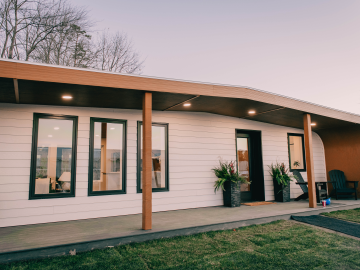
Filter News
Area of Research
News Type
News Topics
- (-) Biomedical (5)
- (-) Buildings (9)
- (-) Clean Water (5)
- (-) Coronavirus (3)
- (-) Cybersecurity (9)
- (-) Environment (36)
- (-) Machine Learning (14)
- (-) Mathematics (2)
- (-) Summit (9)
- 3-D Printing/Advanced Manufacturing (15)
- Advanced Reactors (2)
- Artificial Intelligence (25)
- Big Data (9)
- Bioenergy (14)
- Biology (23)
- Biotechnology (4)
- Chemical Sciences (18)
- Composites (4)
- Computer Science (19)
- Critical Materials (2)
- Education (3)
- Emergency (1)
- Energy Storage (14)
- Exascale Computing (14)
- Fossil Energy (2)
- Frontier (17)
- Fusion (9)
- Grid (13)
- High-Performance Computing (31)
- Hydropower (2)
- Isotopes (9)
- Materials (49)
- Materials Science (14)
- Mercury (1)
- Microelectronics (2)
- Microscopy (7)
- Molten Salt (1)
- Nanotechnology (6)
- National Security (19)
- Neutron Science (27)
- Nuclear Energy (19)
- Partnerships (24)
- Physics (14)
- Polymers (3)
- Quantum Computing (9)
- Quantum Science (7)
- Security (3)
- Simulation (26)
- Software (1)
- Space Exploration (4)
- Transportation (9)
Media Contacts

Inspired by one of the mysteries of human perception, an ORNL researcher invented a new way to hide sensitive electric grid information from cyberattack: within a constantly changing color palette.

On the grounds of the University of Maine’s Advanced Structures and Composites Center sits the nation’s first additively manufactured home made entirely from biobased materials - BioHome3D.

Climate change often comes down to how it affects water, whether it’s for drinking, electricity generation, or how flooding affects people and infrastructure. To better understand these impacts, ORNL water resources engineer Sudershan Gangrade is integrating knowledge ranging from large-scale climate projections to local meteorology and hydrology and using high-performance computing to create a holistic view of the future.

A team of researchers from ORNL was recognized by the National Cancer Institute in March for their unique contributions in the fight against cancer.

The public is invited to six nature walks designed to highlight not only the rich flora and fauna diversity of the Oak Ridge Reservation, but also to demonstrate the work being done to sustainably manage and conserve this valuable resource.

A team of scientists led by the Department of Energy’s Oak Ridge National Laboratory designed a molecule that disrupts the infection mechanism of the SARS-CoV-2 coronavirus and could be used to develop new treatments for COVID-19 and other viral diseases.

A technology developed at ORNL and used by the U.S. Naval Information Warfare Systems Command, or NAVWAR, to test the capabilities of commercial security tools has been licensed to cybersecurity firm Penguin Mustache to create its Evasive.ai platform. The company was founded by the technology’s creator, former ORNL scientist Jared M. Smith, and his business partner, entrepreneur Brandon Bruce.

ORNL is teaming with the National Energy Technology Laboratory to jointly explore a range of technology innovations for carbon management and strategies for economic development and sustainable energy transitions in the Appalachian region.

Scientists at ORNL have confirmed that bacteria-killing viruses called bacteriophages deploy a sneaky tactic when targeting their hosts: They use a standard genetic code when invading bacteria, then switch to an alternate code at later stages of
The Autonomous Systems group at ORNL is in high demand as it incorporates remote sensing into projects needing a bird’s-eye perspective.


